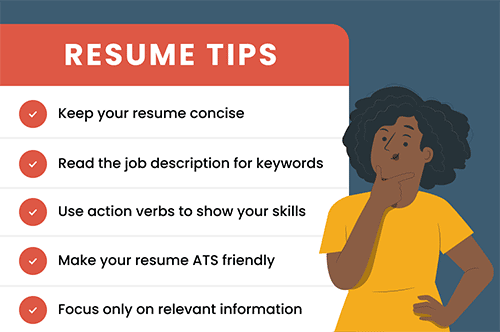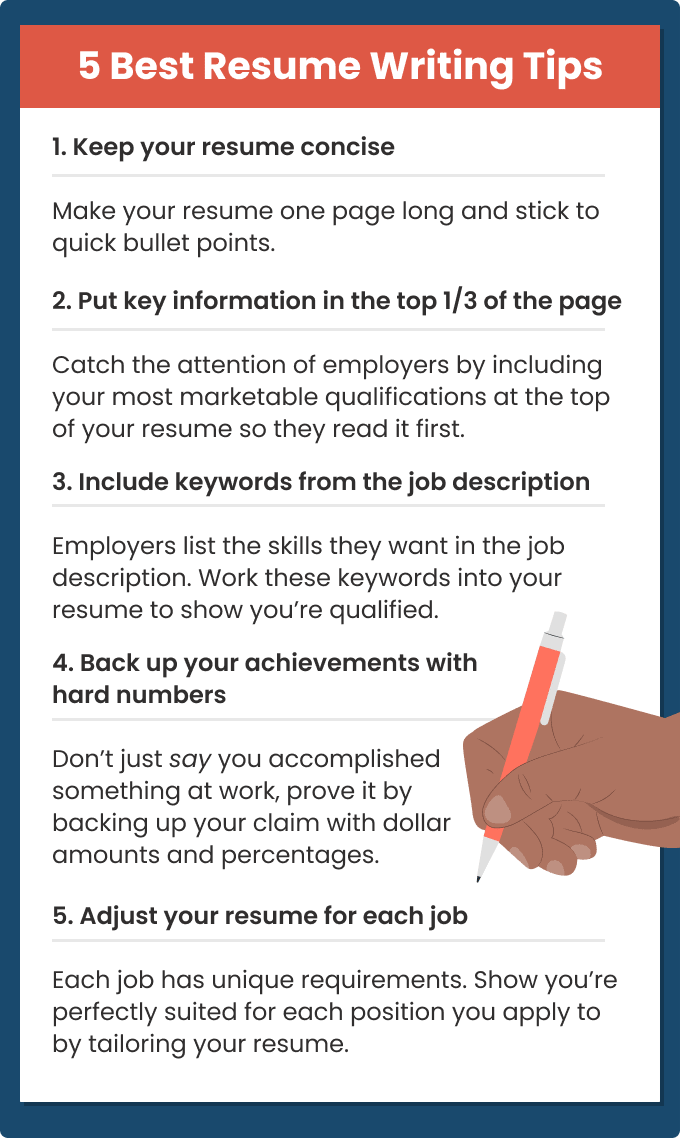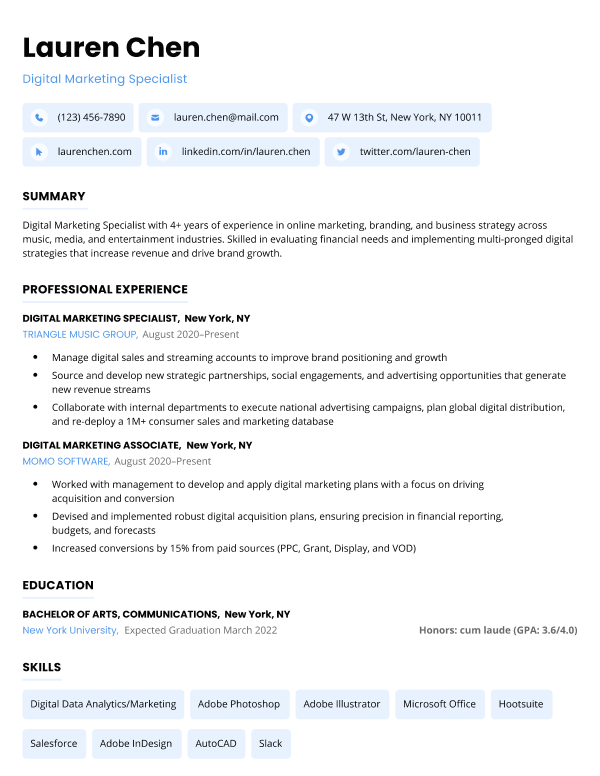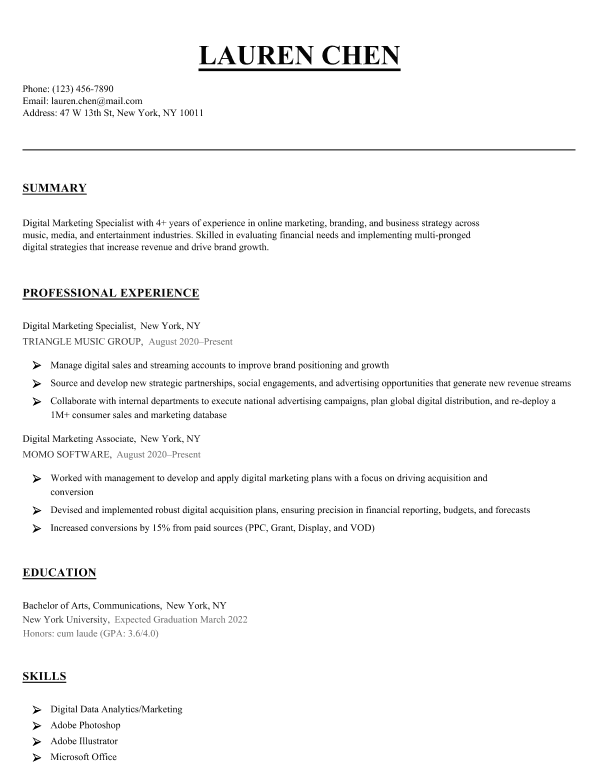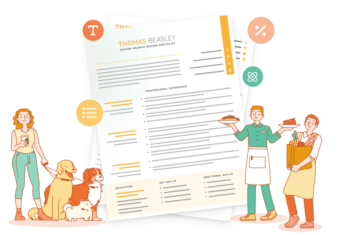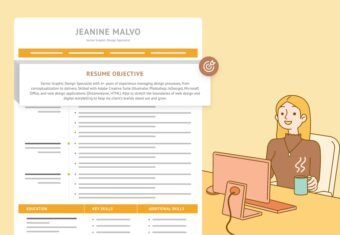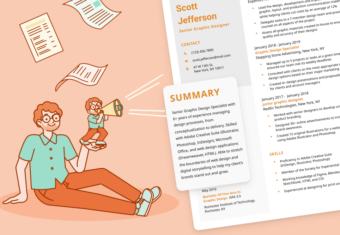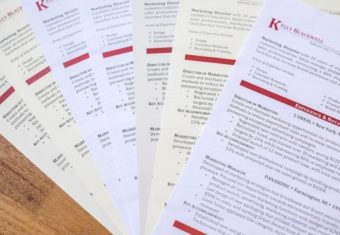You might already know the basics of how to make a resume, but if you want to get hired in 2024 your resume needs to stand out from the rest.
To help you do just that, we’ll go over some resume dos and don’ts. We’ve put together 35+ insider resume tips to help you improve your resume and show employers you’re the right person for the job.
Resume writing tips
After much internal debate, we’ve narrowed down a list to 35 of our best resume writing tips and tricks. In no particular order, let’s get to it:
Our free-to-use resume builder can make you a resume in as little as 5 minutes. Just pick the template you want, and our software will format everything for you.
1. Keep your resume concise
Hiring managers are busy people. One way to make sure they read all of the information on your resume is by keeping your content informative and short.
As you’re writing your resume, only focus on your most important accomplishments. Condense as much information as possible, and cut unnecessary words.
Words you should avoid on your resume include:
- Articles (a, an, the)
- Pronouns (I, they, we)
- Adverbs (words ending in “-ly”)
- Overly wordy phrasing (for example, “responsible for the implementation of” can simply be “implemented”)
Providing too many details on your resume will make a hiring manager zone out. If the hiring manager loses interest while reading your resume, they’re much less likely to remember your application and get in touch with you.
2. Read the job description for keywords
The best way to start working on your resume is by reviewing the job description for the position you want.
Typically, employers list the exact skills, experience, and talents they’d like each candidate to have directly in the job description.
As you’re writing your resume, take note of any keywords you spot in the description. Highlight as many of these keywords as you can to show employers that you’re the perfect candidate for the position.
Here’s an example of a job ad for an administrative assistant position with the skill-related keywords highlighted:
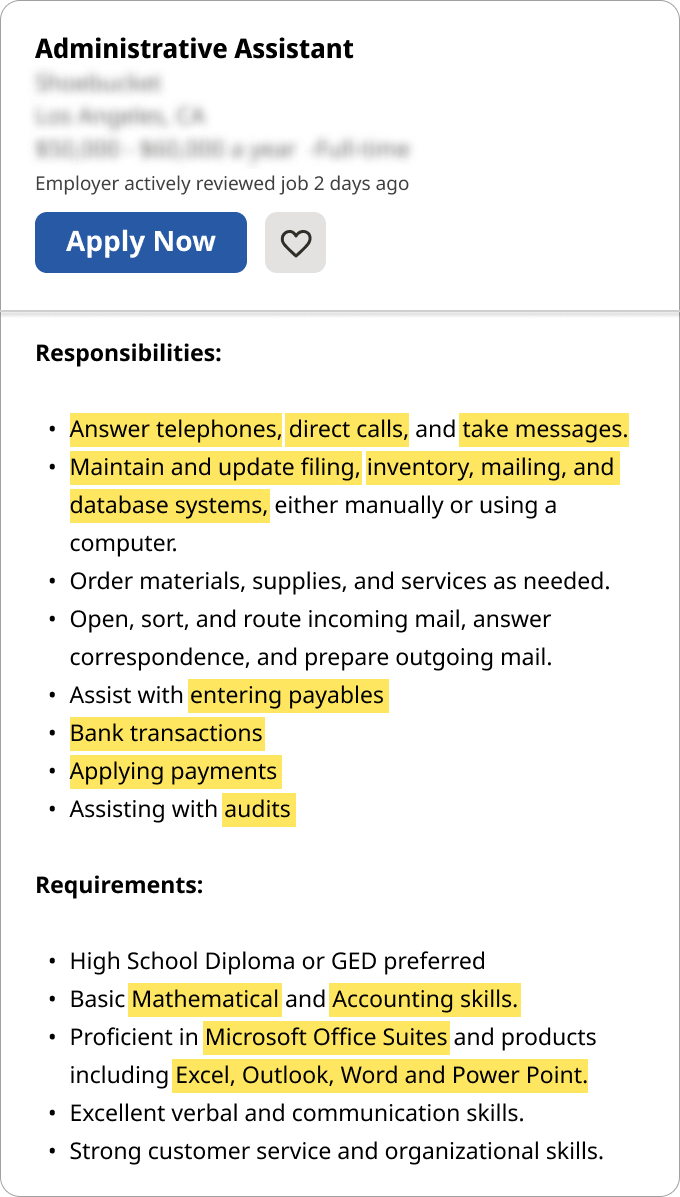
3. Look at other resume examples for inspiration
Not sure what kind of information to put on your resume? You’re not the only one.
Fortunately, there are plenty of resources available online that can help guide you. Reviewing resume samples written by other people who work in your industry is a helpful way to jumpstart the resume writing process and give you inspiration for what you need to put on your resume.
Additionally, looking at examples will give you an idea of how formal you need to make your resume and how to format each section.
4. Use action verbs to show off your skills
Many job seekers start their resume bullet points off with phrases like “Responsible for” and “Tasked with”. While these phrases are okay, they don’t do a great job of describing what you actually achieved at work.
Instead, you should begin each bullet point of your resume with action verbs that highlight your accomplishments. These power words will help your resume stand out by clearly explaining your job duties and how you contributed to the company’s goals.
Here’s an example of resume bullet points that can be improved using action verbs:
Good
- Innovated new digital filing system, simplifying input process to save 9 hours per month
- Motivated team of 5 direct reports to meet or exceed sales targets
Not So Good
- Tasked with creating a new digital filing system, simplifying input process to save 9 hours per month
- Managed team of 5 direct reports
There’s a reason this is one of our favorite resume tips — simply adding action verbs makes your resume immediately sound more impressive.
5. Put key information in the top third of your resume
In an ideal world, the hiring manager would have plenty of time to carefully review your resume.
However, in reality, that’s not often the case. Most hiring managers only read the top third of your resume. If you don’t catch their attention, they’ll just skim through the rest of your information.
Our insider trick is simple: put the information you most want employers to see at the top of the page.
For example, if you’re a recent graduate, your education is probably your biggest selling point. In this case, list your education section toward the top of the page to make sure employers see it.
6. Add hard numbers to demonstrate your achievements
Impress hiring managers by using numbers to give more context to your accomplishments. Adding numbers gives hiring managers a clearer picture of what you can do for their company if hired.
For instance, instead of just saying you increased revenue or efficiency, dig up some actual data. Ask yourself the following questions:
How many people did you train? By what percentage did you increase sales? How much revenue did you generate?
Adding hard numbers to quantify your resume is one of the steps to making a STAR method resume, and it makes your achievements easier to understand for the hiring manager — giving them a reference for what you can accomplish for them if hired.
7. Highlight your accomplishments (not your responsibilities)
When most job seekers write their resumes, they tend to focus only on what they’re responsible for.
One of the most effective ways to level up your resume is to make your experience section accomplishment-oriented.
Focusing on your achievements proves to hiring managers that you’re more than just a drone who can complete tasks, and that you can be trusted to handle the demands of your job.
For example, let’s say you’re looking for a sales job. Instead of writing this on your sales resume:
- “Handled a variety of sales-related responsibilities, such as interacting with clients and supporting the sales team in achieving targets,”
write something like this to show that you’re results-focused:
- “Successfully managed end-to-end sales processes, contributing to a 15% increase in monthly revenue by consistently exceeding sales targets and fostering strong client relationships.”
8. Focus only on relevant information
A lot of job seekers think their resume is the place to list every job they’ve ever had. However, not every job is relevant to the position you want.
If you only focus on the skills and experience directly relevant to the job you’re applying for, your resume stands a better chance of earning you an interview.
For example, if you’re writing a paralegal resume, including the job you had bussing tables at a restaurant wouldn’t help your application. Few of the skills you picked up bussing are going to be relevant to what you’d be doing as a paralegal, so it’s better to leave them off your resume.
9. Stick to your more recent experience
If you’re already a decade or so into your career, then you probably have more than a few relevant positions to list on your resume.
However, many job seekers take the “include relevant experience” idea a little too far and fill up multiple pages with an overview of their entire work history. Doing this quickly guarantees that hiring managers zone out and don’t actually read your resume.
A general resume writing rule is that you should only include work experience as far back as 15 years. Anything before that isn’t useful anymore, unless it includes a notable achievement or is incredibly relevant to the position.
Focusing on your more recent experience (and leaving graduation dates off your resume) is also a good way to combat age discrimination during your job search.
10. Use an online resume builder
Manually making your resume increases the chances that you’ll end up with typos, formatting mistakes, and less-than-impressive bullet points.
Using an online resume maker app is a great way to save time and end up with an effective resume that’ll impress hiring managers. Resume builders help you with your resume writing by filling out every section of your resume, providing pre-filled bullet points, and formatting it all for you.
The end result? You have a great looking resume and you save a bunch of time that you can then use to work on your job hunt.
Most resume builders charge a fee. Before you decide on using a builder, you should research the best resume builder websites and find one that fits your budget.
11. Avoid buzzwords
“Go-getter”, “results-driven”, “synergize” – a lot of job seekers think using buzzwords like these on their resume will magically impress employers.
But the reality is that most hiring managers see buzzwords on your resume and immediately roll their eyes. These phrases are cliché, and actually communicate very little about your skills and experience.
Instead of relying on buzzwords, stick to simple descriptions that clearly communicate your strengths on your resume.
12. Include non-traditional experience
One of the biggest mistakes job seekers just entering the workforce make is thinking that their resume is only for formal work experience.
That’s just not true. Your resume should include all your relevant experience, including experience that isn’t a regular full-time job.
For example, relevant coursework, volunteer work, extracurriculars, and freelance work all make great resume additions. This is especially true if you lack work experience or are writing a career change resume.
13. Downplay any gaps in your work history
If you have long employment gaps, it can seem like a resume red flag to employers. Instead of letting employers assume the worst, take control of the situation.
However, this doesn’t mean twisting the truth and claiming you’ve been employed the entire time — lying on your resume is a common resume mistake to avoid. Instead, one solution is to remove precise months from your work experience section and only display the years you were employed.
If you really want to de-emphasize significant resume gaps, try using a functional resume format. Functional resumes focus primarily on your relevant skills, instead of the jobs you’ve held and when you held them.
You can also explain an employment gap in your resume by clearing things up in your resume summary. Most employers will be understanding if you had a good reason for being unemployed.
14. Use a professional email address
Your email is how nearly all employers are going to reach out to you, so it needs to be professional.
If you’re sending your resume by email, stick with some variation of your name and avoid things like nicknames and too many numbers.
15. List relevant social media accounts
Including social media accounts on your resume is a great way to provide a more complete picture of your professional background.
These days, you should always add your LinkedIn to your resume.
If you work in social media or photography, linking to your Twitter or Instagram is also acceptable. However, make sure the content of your social media account is relevant to the job you want before putting it on your resume.
Additionally, if you work in graphic design or copywriting you should include a link to your website or portfolio.
16. Keep personal details to yourself
While employment discrimination is illegal, it still happens all the time. Including personal information about yourself makes it easier for companies to discriminate against you.
Keep information like this off your resume:
- Date of birth
- Ethnicity
- Nationality
- Religion
- Sexuality
- Political leanings
17. Adjust your resume for each job
While using a general resume is a good way to save time, if you really want to edge out other job applicants you need to tailor your resume.
Every job has different requirements, even within the same industry. If you want to maximize your chance of landing a position, your resume needs to address those unique requirements.
For every job you apply to, adjust your resume to target the specific skills, experience, and interests that employer is looking for.
As an example, take a look at these two social media manager job ads:
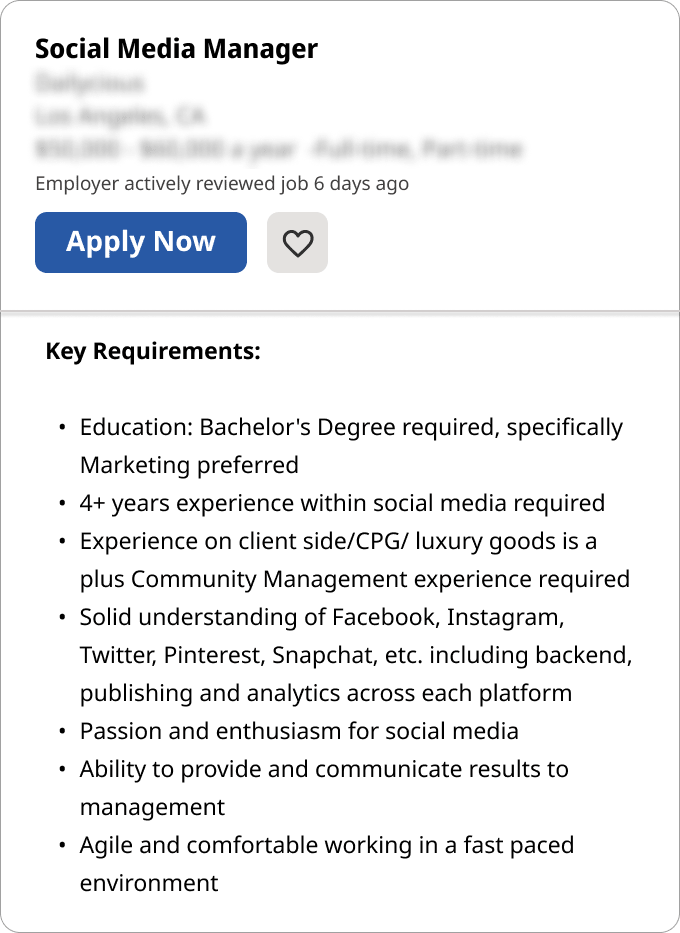
Job ad #1
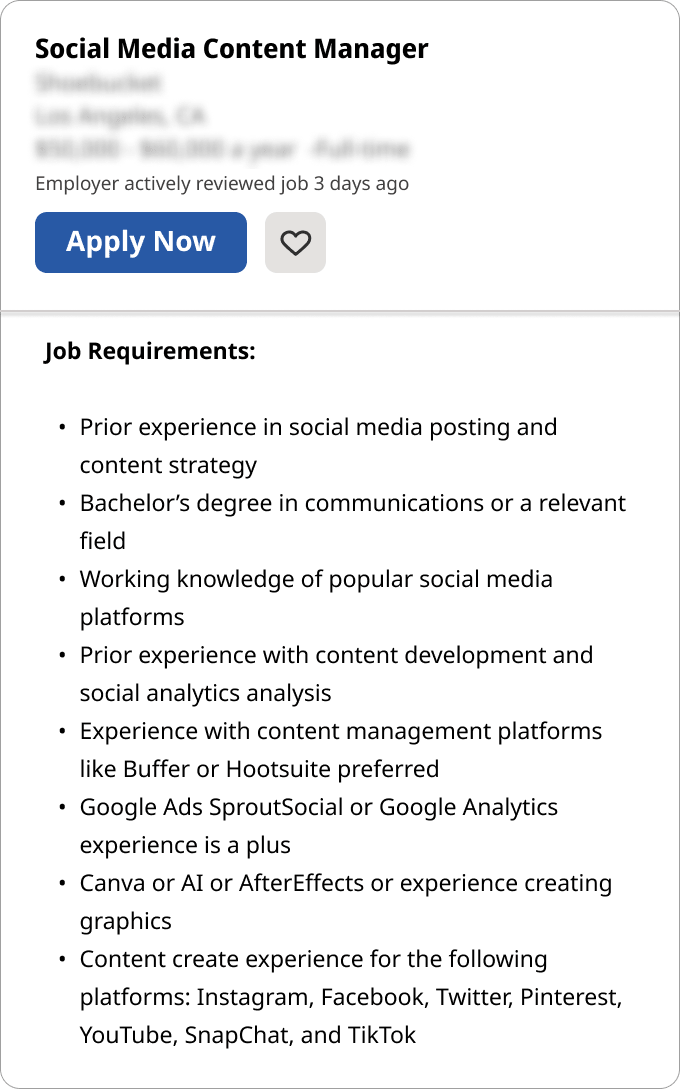
Job ad #2
Notice that while both these job ads are for a social media manager position, the first one is looking for a candidate with community management and analytics experience, while the second ad puts more emphasis on content management.
Even within the same industry, job requirements can have big variations. To make sure you show employers you’re qualified, you should always tailor your resume to the specific position you want.
18. Don’t write “references available upon request”
In the past, it was a common practice to write “references available upon request” on your resume.
However, if employers like your application and want your references they’ll just ask you for them.
With that in mind, it’s a waste of space to include references on your resume or write “references available upon request.”
19. Use a template to help guide you
If you’ve ever tried to design and format your own resume, you know that it requires a ton of time and effort — energy that would be better spent finding and applying for jobs.
Unless you specifically want to show off your graphic design skills, there’s no reason to make your own resume from scratch.
Instead, download one of the many free resume templates available online (Google Docs even has resume templates), and fill it out with your information. You’ll end up with a great looking resume that’s perfectly formatted, and save time in the process.
Use a resume template that has a matching cover letter template. Consistent formatting helps hiring managers keep your application documents together.
20. Proofread – and then proofread again
Even the most confident writer isn’t immune to typos. Once you’ve finished writing, double-check, and then triple-check, your resume for small errors.
Ideally, ask a friend to proofread it too — a fresh set of eyes may catch something you overlooked.
If there are mistakes on your resume it reflects poorly on your attention to detail, which could hurt your chances of employers inviting you in for an interview.
Many free resume review sites will also check your resume for typos and other mistakes.
Resume formatting tips
Once you’re done writing your resume, make sure it looks good and is professionally formatted.
Here are 10 resume formatting tips and tricks to help you make your resume look more professional and easier to read:
21. Keep your resume to one or two pages
While some people find it difficult to find enough content to fill one page of their resume, others have the opposite problem.
Submitting an overly long and detailed resume is one of the easiest ways to guarantee that hiring managers don’t carefully read your job application.
For entry- and mid-level professionals, a one-page resume is the ideal resume length. However, a two-page resume is fine if you have more than 10 years of relevant work experience and want to showcase all of your qualifications.
22. Order resume sections by strength
There’s no single way to set up your resume. If one section of your resume highlights your selling points better than the other sections, don’t be afraid to list it above the other parts of your resume so that employers notice it quickly.
For example, if you have plenty of professional experience and it’s your best selling point, place that above your education. On the other hand, if you’re a recent graduate with only internship experience, put your education at the top.
Having trouble figuring out how to arrange all your information on the page? Try using a resume outline to help you organize the sections of your resume.
23. Use the chronological resume format
Most HR departments favor the chronological resume format, which lists your experience from most to least recent.
Simply put, your newest work experience is (likely) the most relevant, and will leave the greatest impression on the hiring manager.

The best format for your resume
Learn how to pick a resume format that highlights your strengths and downplays your weaknesses by reading our HR-approved guide.
In exceptional cases (like if you’re changing careers or have large gaps in your work experience), however, the functional resume format is a great way to showcase your skill set over your professional experience.
24. Choose a style that reflects your industry
This is one of our most important resume tips (because we see candidates mess this up all the time).
Your resume design should always be appropriate for the job you want.
For example, if you’re applying for a more casual job like those in marketing or design, use a more modern or creative resume template.
However, if you’re applying for a more traditional job like those in law or finance, stick to clean lines, dark colors, serif fonts, and simple layouts.
Here’s a quick illustration of what a more casual resume looks like compared to a formal one:
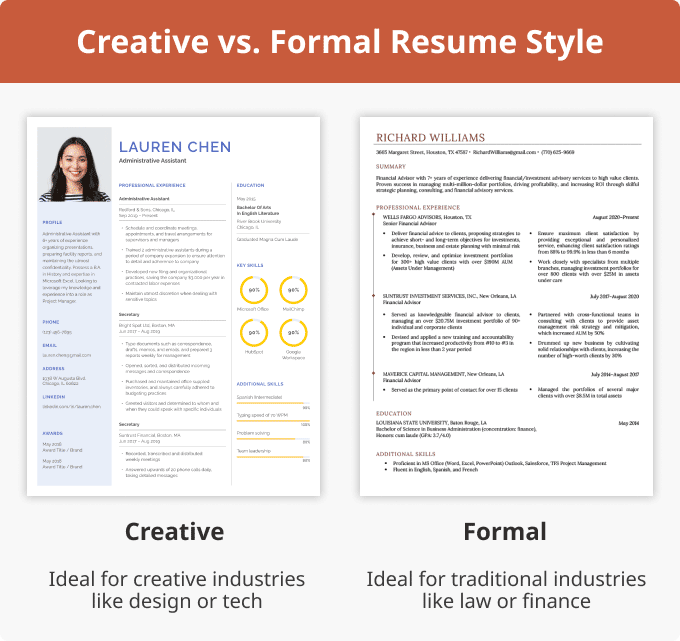
Submitting a colorful resume for a formal position comes across as unprofessional, and can hurt your chances of landing the job.
25. Stick to standard margins
Setting your resume margins too small or too wide makes your resume difficult to read.
Stick to a standard range of ½”–1”, setting them wider if you have less information to put on your resume, and narrower if you need to fit more on the page.
26. Use appropriate fonts
Considering everything you have to think about when making a resume, font choice feels like a minor detail.
However, many job seekers make the mistake of using strange or nontraditional fonts on their resume. The result is that their job application (no matter how qualified they are) looks unprofessional and difficult to read.
When in doubt, the best fonts for your resume are simple classics like:
- Calibri
- Helvetica
- Arial
- Times New Roman
- Georgia
27. Select appropriate resume colors
Another small but essential detail, the colors you use on your resume can have a big impact on your job application.
If you’re applying to a job in a traditional industry, like law or accounting, consider using no color on your resume, or use a professional resume color like dark blue or green.
If you’re applying to a job in a more modern industry like graphic design, marketing, or fashion, you can safely choose from a more creative color palette. However, keep things simple and don’t overload your resume with several different colors because this can look distracting.
28. Go easy on the CAPS
PAY ATTENTION TO THIS RESUME TIP.
Now that we’ve got your attention, it’s important that you avoid over-capitalizing your resume.
All caps should only be used for your name and section headings. Capitalizing everything in your experience section wastes space and makes it look like you’re arguing with someone on an internet forum.
29. Don’t include a headshot
If you’re applying for jobs in the US or UK, don’t include a picture on your resume.
Adding a photo of yourself creates opportunities for hiring bias that most companies want to avoid, making it more likely that they’ll reject your application.
Additionally, adding a picture comes across as strange to most American hiring managers.
The only exception is if you’re writing a modeling or an acting resume, in which case a photo should be included because it’s relevant to the job.
30. Save your resume as a PDF
If you’re making your resume in Word, you’re probably saving it in .doc format.
However, it’s worth saving your resume as a PDF file as well. PDFs retain their formatting regardless of how they’re viewed, so they’re your best bet when sending your application out electronically.
31. Give your resume file a clear name
We can’t tell you how many job applicants submit resumes that are just named “resume.pdf”.
While this won’t result in your application being rejected, vague resume names make it difficult for hiring managers to find your information when they want it.
Instead, make the job application process easier for everyone by including your full name in your resume’s file name, like this: john-smith-resume.pdf
Job search advice
Crafting a good resume is only half the battle. These job search tips will help you check all the right boxes as you complete your applications.
32. Put your resume online
A lot of recruiters and hiring managers use the information you put online to determine whether you’re qualified for a job or not.
Get ahead of the process by uploading your resume to LinkedIn or other job search sites such as Indeed or Monster.
Just be sure to remove all personal information from your resume (like your phone number and location) before uploading it online. Recruiters who come across your resume can use the platform’s messaging function to get in touch with you.
33. Pair your resume with a convincing cover letter
Cover letters aren’t just a formality in the job application process.
Including a cover letter with your resume provides hiring managers insight into how your experience matches their requirements and why you’re interested in that job specifically. Even if it’s not required, you can include a short cover letter with your application to introduce yourself and explain why you’re the best fit for the role.
Knowing how to write a good cover letter can elevate your resume and quickly take your job application to the next level.
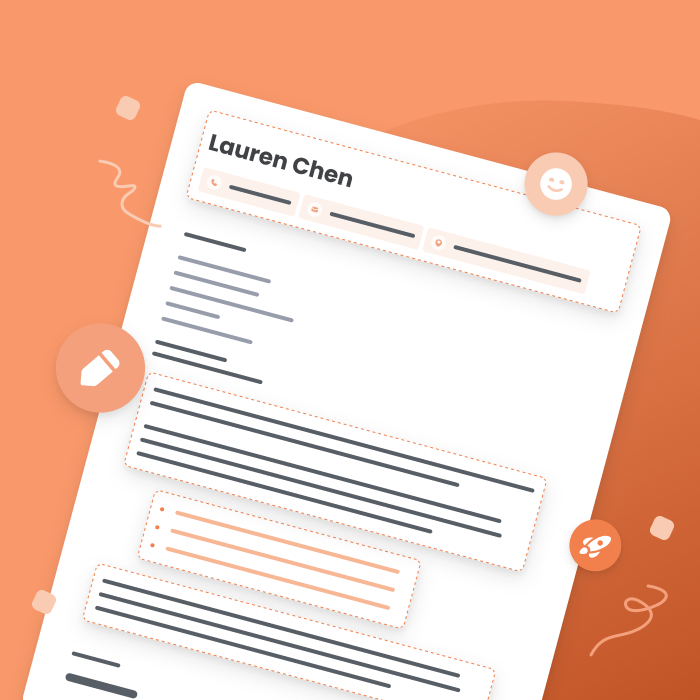
Dread writing cover letters? Read our guide to learn how to write a great cover letter that convinces hiring managers you’re the ideal person for the job.
34. Remember to attach all documents
Most email clients won’t remind you to click “attach”, and there are few things more embarrassing than sending two emails to an employer because you forgot to include everything the first time.
Before you click “Send” on your job application, double-check the whole message, the recipients, subject line, text body, and attachments to make sure everything looks perfect. You don’t want to leave a negative first impression with careless mistakes like using three different spellings of “resume”.
If you’re submitting your resume in person, remember to use an appropriate resume paper.
35. Last but not least, follow up!
These days it’s expected that you’ll follow up your application with an email or phone call. Not just to confirm whether the employer received your paperwork, but also to ask if they had any questions and express your desire to discuss the job in person.
By calling or emailing after sending your resume you’re indicating persistence, diligence, and a strong desire to be the candidate they hire.
And if you progress to the interview stage, it’s polite to send a thank you letter and reiterate your enthusiasm for the position if you felt the interview went particularly well.
Click to rate this article
4.7 Average rating


